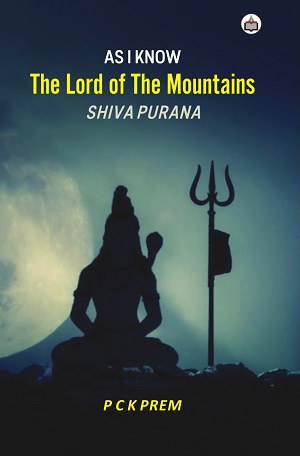Nov 29, 2025
Nov 29, 2025
by P C K Prem
As I Know: The Lord of the Mountains – Shiv Purana: 12
Suta speaks about the glory and splendeur of earthly images of Shiva…worship of earthen phallic images – the parthiva linga religiously after fulfilling rituals and rites, bestows desired results not only on gods and celestial beings, daityas, snakes, gandharavas etc but also on all.
 On the request of sages, monk Suta speaks on the glory and magnitude of earthly phallic image of Shiva. Many brahmins, Sri Hari, Brahma and Prajapati attained desired results through the worship of earthen phallic image and so the gods, demons, human beings, gandharavas, serpents and raksasas also worshipped earthly image of Shiva and attained the objective. Each age considered its own image of Shiva as the best – in the age of Dwapara it was of gold, in Treta it was of mercury and in Kaliyuga it is of earth of which Earthen body is the best and everyone worships it with great benefits. Shiva is the oldest and excellent among the deities. Then Suta gives a few examples of its greatness.
On the request of sages, monk Suta speaks on the glory and magnitude of earthly phallic image of Shiva. Many brahmins, Sri Hari, Brahma and Prajapati attained desired results through the worship of earthen phallic image and so the gods, demons, human beings, gandharavas, serpents and raksasas also worshipped earthly image of Shiva and attained the objective. Each age considered its own image of Shiva as the best – in the age of Dwapara it was of gold, in Treta it was of mercury and in Kaliyuga it is of earth of which Earthen body is the best and everyone worships it with great benefits. Shiva is the oldest and excellent among the deities. Then Suta gives a few examples of its greatness.
If Ganga is oldest, most sacred, earthen phallic image of Shiva is the best, and so he speaks of Pranava, Brahmins, Kashi city, Shivaratri etc that are supreme and sacred among mantras, varnas, holy cities and holy days like Shivaratri. Worship of any other deity is fruitless. Propitiation of earthen image blesses the devotees with health, wealth and fortunes. Devotion and worship of the image blesses with affluence and glory. A true devotee becomes identical with Rudra. Suta continues to speak about the blessings, and gives details of the immense benefits and blessings if one worships the earthen image of Shiva after following appropriate procedure of rituals and rites.
Next, he speaks about the manner of worshipping an earthen phallic image with chanting of mantras. This worship bestows worldly pleasures and salvation on the devotees who love, learn and worship the Vedas . A devotee must take bath, cleanse body and then, pray at appropriate hours of the day and it includes Brahmayajna. It is good to perform rites of offering water oblations to the manes, the pitres. After finishing rites, a devotee should apply ashes on the body and wear rudraksa and keep lord Shiva in mind while he worships earthen phallic image as per the injunctions of the Vedas and that would help him realise benefits.
It is auspicious to worship the holy earthen image on the riverbank, near a water lake or on the mountaintop or in a forest or some temple of Shiva. A devotee should be sure about the cleanliness of the place. Clay from holy and clean place is good for making the phallic image. He tells that brahmin should use white clay, red clay is good for Ksatriya, yellow for vaisya and black for sudra and if the right clay is not available, accessible or easily obtainable clay is fine. Purity of place and time and Vedic directives need care. Its worship now, will bestow worldly pleasure and salvation later on, and so the great monk continues to speak of the phallic worship and its fruit if a devotee performs with right japa of mantras.
Rituals and rites are essential for the right installation of phallic image of Shiva while taking care of the Vedic path, right mantras and observance of sacred and clean approach with chanting of mantras with the ritualistic touching of different parts of body. Nyasa of the deity is must. With chant of mantra, washing of feet yields blessings. Each act during worship needs japa of right mantra with oblations etc.
After different and complicated approach to the worship as per the Vedic mode of worship, Suta speaks of simple procedure of worship of Shiva. Prayer and worship with the whispering of names of Shiva, fulfills cherished desires but wants devotees religiously to adhere to the directions regarding apt arranging of material for worship, rites of bringing the clay, kneading etc. The mode appears difficult but if a devotee worships it properly, it pleases the great lord, the primordial Being, the seed of the universe, who dispels fears and who is the three-eyed lord with five faces. Meditation and worship of beautiful earthly phallic image, and thereafter japa of the five-syllable mantra as the preceptor taught brings excellent fruit and then, prayer with the sacred hymn in praise of the lord will bless the devotee.
Suta tells to sing glory – ‘O Shiva, be merciful. I am your devotee.’ If a devotee constantly, consciously or unconsciously chants mantra, is engaged in japa, the lord acts as a sanctifier and purifier and so blesses a sinner and makes him better. The devotees know that Shiva is beyond the Vedas, Puranas and philosophy of sages and finally, seek his blessings. After the singing of glory of the lord through a long hymn Suta tells, the devotee shall offer flowers and akshat – rice grains over the phallic image of Shiva and then, bow and prostrate before the holy image with devotion and so will attain the desired fruit.
Continued to Next Page
02-Oct-2021
More by : P C K Prem